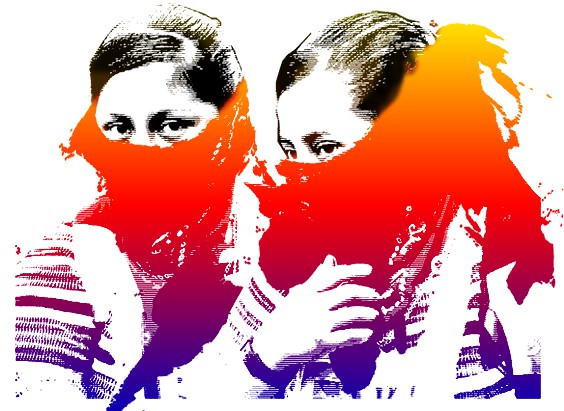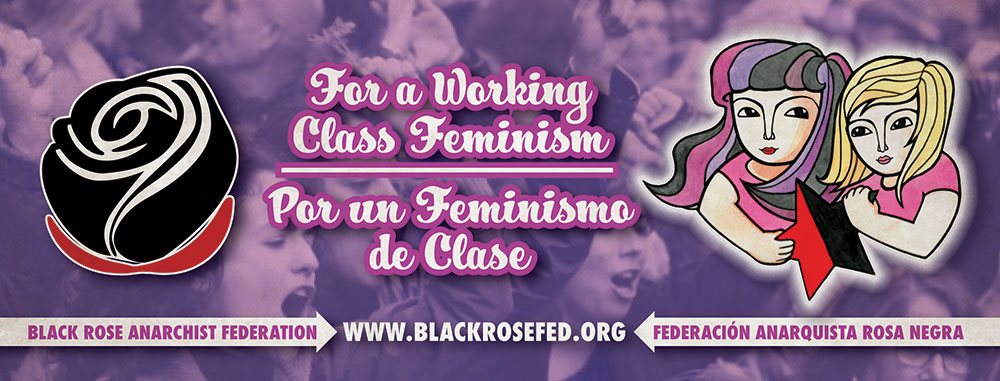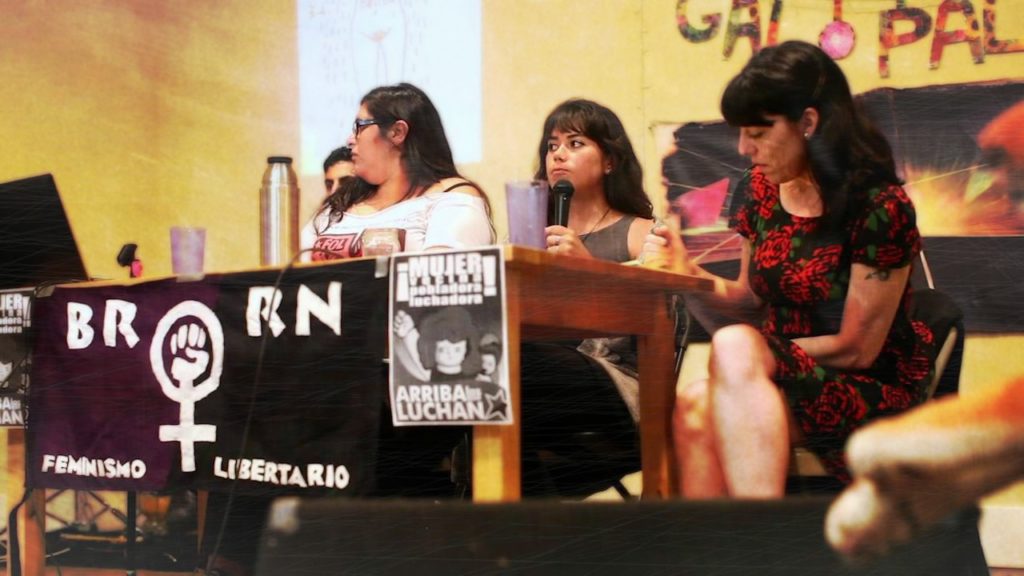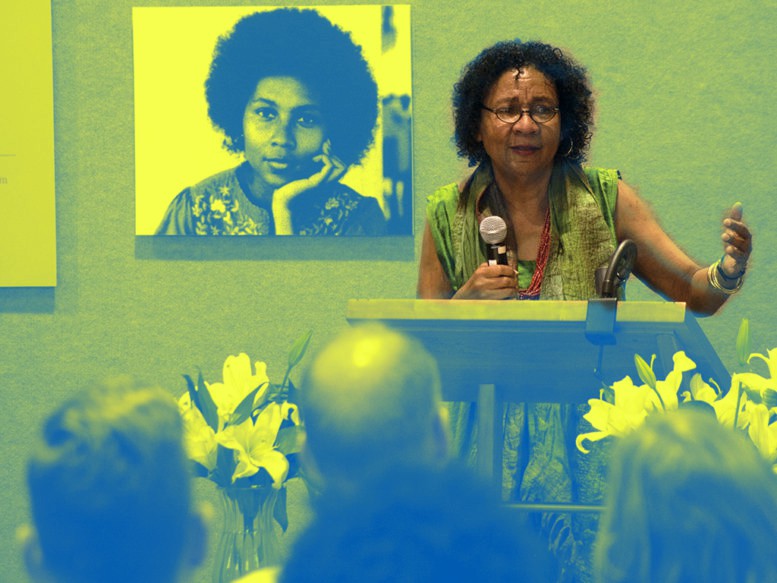
This essay argues that anarchists can learn from the theory of “intersectionality” that emerged from the Black feminist movement. Indeed, anarchist conceptions of class struggle have widened as a result of the rise of feminist movements, civil rights movements, as well as the gay, lesbian, queer and trans liberation movements. What can be learned and how do we see their relationship to class struggle? Do we dismiss them as “mere identity politics” or are there valuable overlaps and influences that should be incorporated? – A PDF pamphlet version of this article can be found HERE. Originally published in 2009.
By Deric Shannon and J. Rogue
Anarchism can learn a lot from the feminist movement. In many respects it already has. Anarcha-feminists have developed analyses of patriarchy that link it to the state form. We have learned from the slogan that “the personal is political” (e.g. men who espouse equality between all genders should treat the women in their lives with dignity and respect). We have learned that no revolutionary project can be complete while men systematically dominate and exploit women; that socialism is a rather empty goal–even if it is “stateless”–if men’s domination of women is left intact.
This essay argues that anarchists can likewise learn from the theory of “intersectionality” that emerged from the feminist movement. Indeed, anarchist conceptions of class struggle have widened as a result of the rise of feminist movements, civil rights movements, gay and lesbian liberation movements (and, perhaps more contemporarily, the queer movements), disability rights movements, etc. But how do we position ourselves regarding those struggles? What is their relationship to the class struggle that undergirds the fight for socialism? Do we dismiss them as “mere identity politics” that obscure rather than clarify the historic task of the working class? If not, how might anarchists include their concerns in our political theory and work?
Why Intersectionality? How We Got Here

Many people locate the beginning of the feminist movement in the U.S. with the struggle of women to gain the vote. This focus on electoralism was criticized for its narrowness by many turn-of-the-century radical women. After all, what did the vote provide for working class women? How could voting for a new set of rulers put food in their mouths and the mouths of their families? In fact, many radical women of this time period refused to identify as “feminists”, as they viewed feminism as a bourgeois women’s movement unconcerned with the class struggle (for an interesting discussion of this in the context of early 1900s Spanish anarcho-syndicalism, see Ackelsberg 2005: 118-119 and 123-124). Indeed, many working class women saw their “feminist” contemporaries as being in alliance “with all the forces that have been the most determined enemies of the working people, of the poor and disinherited”–that is, they saw the early feminist movement as a purely bourgeois women’s movement that had no solutions to the pervasive poverty and exploitation inherent in the working class experience in a classed society (Parker 2001: 125).
Anarchists of this time period, on the other hand, at times anticipated some of the arguments to come out of the feminist movement regarding intersectionality. We argued against the class reductionism that often occurred within the broader socialist milieu. Early anarchists were writing about issues such as prostitution and sex trafficking (Goldman 2001), forced sterilizations (Kropotkin 2001), and marriage (de Cleyre 2004 and 2001) to widen the anarchist critique of hierarchy to give critical concern to women’s issues in their own right, while also articulating a socialist vision of a future cooperative and classless society. Much of this early work demonstrated connections between the oppression of women and the exploitation of the working class. The refusal of many working class women to join their “feminist” contemporaries likewise demonstrated some of the problems of a universalized identity-based feminism that saw women’s oppression as a hierarchy that can be fought without also fighting capitalism.
This is not to suggest that anarchists weren’t at times reductionist. Unfortunately, many anarchist men were dismissive of women’s concerns. Part of the reason that the Mujeres Libres saw a need for a separate women’s organization around the time of the Spanish Civil War was because “many anarchists treated the issue of women’s subordination as, at best, secondary to the emancipation of workers, a problem that would be resolved ‘on the morrow of the revolution’” (Ackelsberg 2005: 38). Unfortunately, in some contexts, this attitude isn’t just a historical oddity, though it should be. And it was these kinds of assumptions that became an important theoretical backdrop for feminism’s “Second Wave.”

Competing Visions in the “Second Wave”
During the late 60s through the early 80s, new forms of feminism began to emerge. Many feminists seemed to gravitate to four competing theories with very different explanations for the oppression of women.
Like their historical bourgeois predecessors, liberal feminists saw no need for a revolutionary break with existing society. Rather, their focus was on breaking the “glass ceiling”, getting more women into positions of political and economic power. Liberal feminists assumed that the existing institutional arrangements were fundamentally unproblematic. Their task was to see to women’s equality accommodated under capitalism.
Another theory, sometimes referred to as radical feminism, argued for abandoning the “male Left”, as it was seen as hopelessly reductionist. Indeed, many women coming out of the Civil Rights movement and anti-war movements complained of pervasive sexism within the movements, being relegated to secretarial tasks, philandering male leaders, and a generalized alienation from Left politics. According to many radical feminists of the time, this was due to the primacy of the system of patriarchy–or men’s systematic and institutionalized domination of women. To these feminists, the battle against patriarchy was the primary struggle to create a free society, as gender was our most entrenched and oldest hierarchy (see especially Firestone 1970).
Marxist feminists, on the other hand, tended to locate women’s oppression within the economic sphere. The fight against capitalism was seen as the “primary” battle, as “The history of all hitherto existing societies is the history of class struggles”–that is, human history could be reduced to class (Marx and Engels 1967). Further, Marxist feminists tended to believe that the economic “base” of society had a determining effect on its cultural “superstructures”. Thus, the only way to achieve equality between women and men would be to smash capitalism–as new, egalitarian economic arrangements would give rise to new, egalitarian superstructures. Such was the determining nature of the economic base.
Out of the conversations between Marxist feminism and radical feminism another approach emerged called “dual systems theory” (see e.g. Hartmann 1981; Young 1981). A product of what came to be dubbed socialist feminism, dual systems theory argued that feminists needed to develop “a theoretical account which gives as much weight to the system of patriarchy as to the system of capitalism” (Young 1981: 44). While this approach did much to resolve some of the arguments about which fight should be “primary” (i.e. the struggle against capitalism or the struggle against patriarchy), it still left much to be desired. For example, black feminists argued that this perspective left out a structural analysis of race (Joseph 1981). Further, where was oppression based on sexuality, ability, age, etc. in this analysis? Were all of these things reducible to capitalist patriarchy?
It is within this theoretical backdrop that intersectionality emerged. But it wasn’t just abstraction and theory that led to these insights. As mentioned before, part of the reason feminists saw a need for a separate analysis of patriarchy as a systemic form of oppression was due to their experiences with the broader Left. Without an analysis of patriarchy that put it on equal footing with capitalism as an organizing system in our lives, there was no adequate response to male leaders who suggested that we deal with women’s oppression after we deal with the “primary” or “more important” class struggle.
But these tensions were not limited to the Left, they also existed within the feminist movement. Perhaps one of the best examples of this on the ground was in the pro-choice movement in the United States. Before Roe vs. Wade in 1973, abortion law was considered an issue to be dealt with on a state-by-state basis. Feminists mobilized around Roe Vs. Wade to see that legal abortion would be guaranteed throughout the country. The ruling eventually did give legal guarantees to abortion through the second trimester, but the “choice” and “legalization” rhetoric left too much unaddressed for many feminists.
And this experience set the stage for re-thinking the idea of a universalized, monolithic experience of “womanhood” as it is often expressed in traditional identity politics. Black feminists and womanists, for example, argued that focusing solely on legalized abortion obscured the ways that black women in the United States underwent forced sterilizations and were often denied the right to have children (see Roberts 1997). Further, working class women argued that legalized “choice” is pretty meaningless without socialism, as having abortion legal, but unaffordable, didn’t exactly constitute a “choice”. True reproductive freedom meant something more than just legal abortion for working class women. Many wanted to have kids but simply couldn’t afford raising them; some wanted a change in the cultural norms and mores of a society that judged the decisions women made about their bodies; others wanted proximity to clinics for reproductive health–in short, a “reproductive freedom” framework would take into account the interests of all women, not just be structured around white, heterosexual, middle-class women’s concerns (the seeming default position of the “pro-choice” movement).

Intersections
These experiences within the feminist movement and the broader Left raised many questions for feminists. How do we create a movement that isn’t focused around the interests of its most privileged elements? How do we retain our commitment to socialism without being subsumed into a politic that sees women’s issues as “secondary”? What might political organization look like based on a common commitment to ending domination rather than an assumed common experience based on some single identity? These questions began to be answered largely by feminists of color, queers, and sex radicals with the theory of intersectionality–a theory that was critical of traditional class and identity politics (see especially e.g. hooks 2000; Collins 2000).
Intersectionality posits that our social locations in terms of race, class, gender, sexuality, nation of origin, ability, age, etc. are not easily parsed out one from the other. To speak of a universal experience as a “woman”, for example, is problematic because “womanhood” is experienced quite differently based on race, class, sexuality– any number of factors. As such, a non-reflective feminist movement centered ostensibly on the concerns of “women” tended to reflect the interests of the most privileged members of that social category.
As well, our various social locations and the hierarchies they inform intersect in complex ways and are not easily separable. People don’t exist as “women”, “men”, “white”, “working class”, etc. in a vacuum devoid of other patterned social relationships. Further, these systems of exploitation and oppression function in unique ways. To name two rather obvious examples, class is a social relationship based on the exploitation of one’s labor. As socialists, we seek the abolition of classes, not the end of class elitism under capitalism. This makes class unique. Similarly, the idea of “sexual orientation” developed in the 1800s with the invention of “the homosexual” as a species of a person. This effectively created an identity out of preferred gender choices in sexual partners, more or less ignoring the myriad other ways that people organize their sexuality (i.e. number of partners, preferred sexual acts, etc.). It also effectively limited sexual identity to three categories: hetero, homo, and bi–as if there could not be a large range of attractions and variety within humanity. Part of liberation based on sexuality is troubling these categories to provide a viable sexual/social existence for everyone. This makes sexuality, likewise, unique.
These structured inequalities and hierarchies inform and support one another. For example, the labor of women in child-bearing and rearing provides new bodies for the larger social factory to allow capitalism to continue. White supremacy and racism allow capitalists control over a segment of the labor market that can serve as stocks of cheap labor. Compulsory heterosexuality allows the policing of the patriarchal family form, strengthening patriarchy and male dominance. And all structured forms of inequality add to the nihilistic belief that institutionalized hierarchy is inevitable and that liberatory movements are based on utopian dreams.
Proponents of intersectionality, then, argue that all struggles against domination are necessary components for the creation of a liberatory society. It is unnecessary to create a totem pole of importance out of social struggles and suggest that some are “primary” while others are “secondary” or “peripheral” because of the complete ways that they intersect and inform one another. Further, history has shown us that this method of ranking oppressions is divisive and unnecessary–and worse, it undermines solidarity. As well, when organizing and developing political practice, we can self-reflexively move the margins to the center of our analyses to avoid the biases of privilege that has historically led to so many divisions in feminism and the Left.
A good contemporary example of intersectionality in the context of social movement practice is Incite! Women of Color Against Violence. Incite! “is a national activist organization of radical feminists of color advancing a movement to end violence against women of color and our communities through direct action, critical dialogue and grassroots organizing” (Incite! 2009). One reason Incite! stands out against other anti-violence organizations is their systemic analysis. They see women of color who have experienced violence as living in the “dangerous intersections” of white supremacy, patriarchy, capitalism, and other oppressive structures and institutions. Rather than simply reducing the experiences to the individual, they recognize the systems that oppress and exploit people and have structured their approach in such a way that calls for the “recentering” of marginalized folks, as opposed to a method of “inclusiveness” based on one single identity or social location. Incite! argues that “inclusiveness” simply adds a multicultural component to individualistic white-dominated organizing so common in the United States. Instead, they call for recentering the framework around the most marginalized peoples. This push is to ensure that their organizing addresses the needs of those historically overlooked by feminism, with the understanding that all people benefit from the liberation of their more marginalized peers–while focusing on the more privileged elements within a given social category leaves others behind (as in the examples we gave in the struggle for the vote and the legalization of abortion). Incite! makes a point to focus on the needs of the working class who have generally been neglected (i.e. sex workers, the incarcerated, trans folks and injection drug users). By centering these people in their organizing, they are focusing on the people standing at more dangerous intersections of oppression and exploitation, therefore tackling the entirety of the system and not just the more visible or advantaged aspects. Additionally, Incite! views the state as a major perpetrator of violence against women of color and seeks to build grassroots organizations independent of and against it. Anarchists could learn a lot from Incite! about the importance of addressing the needs of allsections of the working class and their attempt to check the tendency of the Left to ignore or dismiss the concerns, needs, ideas and leadership of people living in the dangerous intersections of capitalism, white supremacy, patriarchy, etc.

And What Can Anarchism Provide the Theory of Intersectionality?
We firmly believe that this learning process is a two-way street. That is, when synthesizing our practice to include these concerns raised by feminists, feminism could stand to benefit from learning from anarchism as well. We see the contributions of anarchists to intersectionality in two major areas. First, anarchism can provide a radical base from which to critique liberal interpretations of intersectionality. Secondly, anarchists can offer a critical analysis of the state.
Too often people using an intersectional analysis ignore the uniqueness of various systems of domination. One way this is done is by articulating a general opposition to classism. While we believe that class elitism exists, often this opposition to “classism” does not recognize the unique qualities of capitalism and can lead to a position that essentially argues for an end to class elitism under capitalism. As anarchists, we do not just oppose class elitism, we oppose class society itself. We do not want the ruling class to treat us nicer under a system based on inequality and exploitation (i.e. capitalism). We want to smash capitalism to pieces and build a new society in which classes no longer exist–that is, we fight for socialism. Anarchists, as part of the socialist movement, are well-placed to critique this liberal interpretation of intersectionality (see especially Schmidt and van der Walt 2009).
Likewise, as anarchists, we are well-placed to put forward our critiques of the state. The state, in addition to being a set of specific institutions (such as the courts, police, political bodies like senates, presidents, etc.), is a social relationship. And the state has an influence over our lives in myriad ways. For example, former prisoners are often unemployable, particularly if they have committed felonies. One only needs to take a cursory glance at the racial and class make-up of US prisons to see how intersectionality can be put to use here. Former prisoners, workers who are targeted for striking or engaging in direct actions and/or civil disobedience, etc. all have specific needs as subjects in a society that assumes political rulers and passive, ruled subjects. And the state tends to target specific sets of workers based on their existence within the dangerous intersections we mentioned above. Anarchists can offer to the theory of intersectionality an analysis of the ways that the state has come to rule our lives just as much as any other institutionalized system of domination. And we can, of course, argue for smashing such a social arrangement and replacing it with non-hierarchical social forms.
Refusing to Wait
In many ways, anarchists have historically anticipated some of the ideas in intersectionality. Further, anarchism as a political philosophy–and as a movement against all forms of structured domination, coercion, and control–seems well-suited for an intersectional practice. Unfortunately, we still have debilitating arguments about what hierarchy is “primary” and should be prioritized above others. Like in times past, this leads to easy division and a lack of solidarity (imagine being told to give up some struggle that directly involves move you for the “correct” or “primary” fight!). Further, the smashing of any structured hierarchy can have a destabilizing effect on the rest, as the simple existence of any of these social divisions serves to naturalize the existence of all other hierarchies.
We’ve tried here to explain the rise of the theory of intersectionality within feminism and describe its contours. Perhaps more importantly, we’ve attempted to relate it throughout this piece to political practice and social movement struggles so as to avoid complete abstraction and theorization apart from practice. We hope that more anarchists become acquainted with intersectionality and put it to positive use in our political work. Finally, it is our hope that more people from marginalized groups refuse to wait, that we recognize the value of all fights against injustice and hierarchy in the here and now–and that we build a reflexive practice based on solidarity and mutual aid instead of divisive prescriptions about what struggles are “primary” and which ones, by extension, are “secondary” or “peripheral”. Rather, they are all linked and we have good reason to refuse to wait until after “the revolution” to address them!
Bibliography
Ackelsberg, Martha A. 2005. The Free Women of Spain: Anarchism and the Struggle for the Emancipation of Women. Oakland: AK Press.
Collins, Patricia Hill. 2000. Black Feminist Thought: Knowledge, Consciousness, and the Politics of Empowerment. New York: Routledge.
de Cleyre, Voltairine. 2001. “They Who Marry do Ill”. Pp. 103-113 in Anarchy!: An Anthology of Emma Goldman’s Mother Earth, edited by Peter
Glassgold. Washington, D.C.: Counterpoint.
_____. 2004. “Sex Slavery”. Pp. 93-103 in The Voltairine de Cleyre Reader, edited by A.J. Brigati. Oakland: AK Press.
Firestone, Shulamith. 1970. The Dialectic of Sex: The Case for Feminist Revolution. New York: Morrow.
Goldman, Emma. 2001. “The White Slave Traffic”. Pp. 113-120 in Anarchy!: An Anthology of Emma Goldman’s Mother Earth, edited by Peter Glassgold. Washington, D.C.: Counterpoint.
Hartmann, Heidi. 1981. “The Unhappy Marriage of Marxism and Feminism: Towards a More Progressive Union.” in Women and Revolution, by Lydia Sargent (ed.). Boston, MA: South End Press.
hooks, bell. 2000. Feminism is for Everybody: Passionate Politics. Cambridge, MA: South End Press.
Incite!. 2009. http://www.incite-national.org/. Last accessed, October 2009.
Joseph, Gloria. 1981. “The Incompatible Menage à Trois: Marxism, Feminism, and Racism.” in Women and Revolution, by Lydia Sargent (ed.). Boston, MA: South End Press.
Kropotkin, Peter. 2001. “The Sterilization of the Unfit”. Pp. 120-123 in Anarchy!: An Anthology of Emma Goldman’s Mother Earth, edited by Peter Glassgold. Washington, D.C.: Counterpoint.
Marx, Karl and Friedrich Engels. 1967. The Communist Manifesto. Harmondsworth: Penguin.
Parker, Robert Allerton. 2001. “Feminism in America”. Pp. 124-126 in Anarchy!: An Anthology of Emma Goldman’s Mother Earth, edited by Peter Glassgold. Washington, D.C.: Counterpoint.
Roberts, Dorothy. 1997. Killing the Black Body: Race, Reproduction, and the Meaning of Liberty. New York: Vintage.
Schmidt, M. & van der Walt, L. 2009. Black Flame: The revolutionary class politics of anarchism and syndicalism. Oakland: AK Press.
Young, Iris. 1981. “Beyond the Unhappy Marriage: A Critique of the Dual Systems Theory.” in Women and Revolution, by Lydia Sargent (ed.). Boston, MA: South End Press.
This article was first published on anarkismo.net in 2009.
